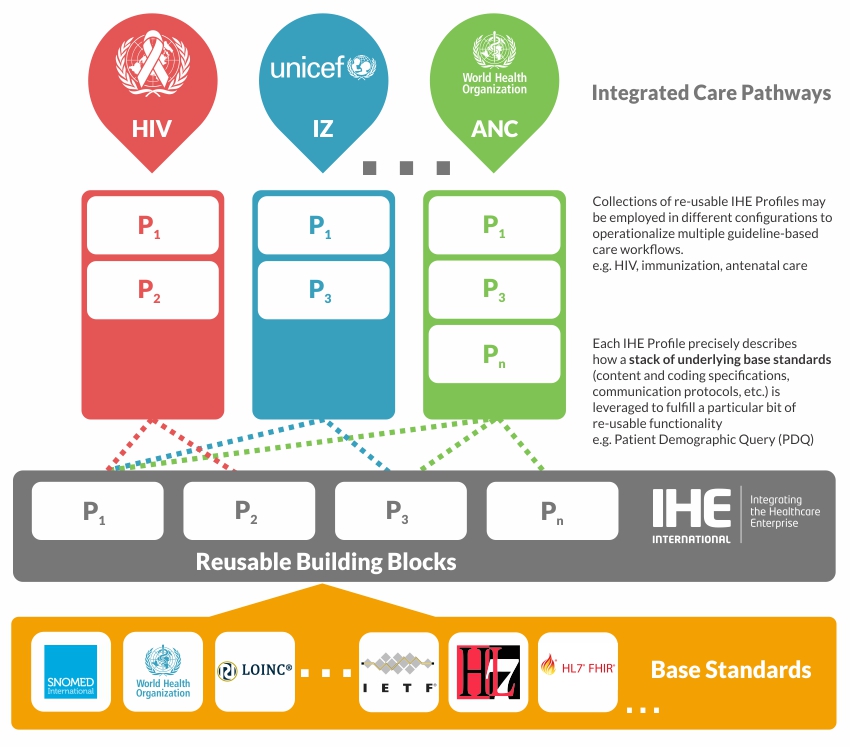Posted on November 9, 2018 by Derek Ritz
In my digital health work here in Canada and around the world, I regularly hear the ill-framed, but nonetheless pertinent question, “With the rising popularity of FHIR, what is the role for IHE?” This question is pertinent because of how much hype currently surrounds the FHIR (Fast Healthcare Interoperability Resources) initiative. There’s concern about how much FHIR is “sucking up all the oxygen” regarding digital health (pun intended) and questions about how to best leverage it to improve health care. The question is ill-framed, however, because it’s predicated on a completely erroneous premise: that digital health interoperability is purely a technology problem.
Interested in helping to advance IHE? Join the upcoming IHE Community meeting on Nov. 21, at 12 p.m. ET.
First, two points need to be clearly made:
- HL7’s FHIR is an important informatics standard that will, over the coming years, become the predominant global specification for health data exchange;
- There is no either/or trade-off between FHIR and IHE.
Standards vs. Profiles
Unlike HL7 (or ISO, or SNOMED, or WHO, etc.), IHE (www.ihe.net) is not a health informatics standards development body. IHE is, rather, a standards profiling body. IHE Profiles are implementation guides — they make standards digestible, usable, and implementable. IHE Profiles describe, at a conformance-testable level of detail, how a portfolio of standards will be employed to address the ecosystem-wide interoperability issues associated with a specific set of health care use cases. IHE Profiles create re-usable, digital health building blocks by “packaging up” the 5 Cs:
- Care context
- Content specs
- Coding specs
- Communications specs
- Confidentiality and security specs

Point-to-point vs. Ecosystem-wide
What is the significance of the distinction between standards and profiles? The answer lies in the relative scopes and differing target audiences of a FHIR specification compared to an IHE Profile (which may, of course, reference underlying FHIR resources).
The FHIR standard describes content, coding and communication specifications for particular health data resources. FHIR specs are written for and targeted at software engineers. The scope of IHE Profiles, however, is to describe the behaviours of participants in a digitally-enabled healthcare ecosystem. In addition to referencing underlying standards, IHE Profiles describe the context within which information exchange will occur and describe constraints on that exchange that reflect mandates regarding privacy, security, auditability, and so on. The target audience for an IHE Profile is the entire care delivery network and, importantly, the entities that govern that network. These entities are tasked with operationalizing plug-and-play interoperability between disparate participants and mandating IHE Profiles (e.g. in RFP specs) gives them a way to do that.
Value Creation vs. Value Capture
The present market hype around FHIR is completely understandable. FHIR is, to be sure, a new and exciting health data exchange technology. In stark contrast, IHE’s important role is to make large and complicated digital health implementations entirely unexciting. IHE addresses ecosystem-wide digital health interoperability as a sociotechnical problem, not merely a technical one. IHE Profiles constrain away the optionality in underlying standards. IHE Connectathons are impartial sources of digital health evidence; they evaporate away ambiguities in a specification and expose product-specific idiosyncrasies in a spec’s implementation. IHE is focused on taking digital health technologies to scale and on mitigating the risks inherent in such an effort.
To quote William Gibson: “the future is already here — it’s just not evenly distributed.” To be sure, few would argue that digital health can add value in a modern health care system. But to realize that value, we will need to widely deploy interoperable solutions that improve care continuity, increase adherence to best-care practices, and enable jurisdictions to enjoy cost-efficiencies across their entire care delivery network. Innovative technologies can certainly create value, but to capture value, scale is the innovation. And this is the very core of IHE’s role: to turn hype into value… to operationalize the Interoperable Healthcare Ecosystem.
![]() What do you think? Join the conversation in the IHE Community forum.
What do you think? Join the conversation in the IHE Community forum.

Derek Ritz, P.Eng., CPHIMS-CA, is the IHE Canada Liaison and comes with national and international experience on broad-scale digital health projects. In addition, he has digital health standards expertise as delegate of Canada to ISO/TC215, IHE technical committee co-chair, IHE International board member, and FHIR.org founding member.


